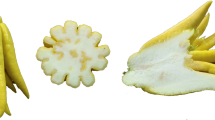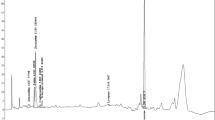Abstract
The aim of this work was to determine the proximate, mineral, amino acid composition, antioxidant activity, anti-nutritional factors, total dietary fiber, total phenolic content and technological properties of C. limetta peels. Moreover, analytical techniques including FT-IR and SEM were also conducted to study the morphological and structural properties of C. limetta peels. Considering the proximate, mineral, and amino acid composition, C. limetta peels was found to be a good source of ash (3.06 ± 0.20%), crude fiber (10.13 ± 0.30%), carbohydrate (64.08 ± 0.55%), protein (7.56 ± 0.25%), potassium (125.9671 mg/100 g), calcium (112.5861 mg/100 g), magnesium (16.43 mg/100 g), asparagine (2111.06 nmol/mg), glutamic acid (1331.96 nmol/g), and aspartic acid (1162.19 nmol/mg). Furthermore, they contain an appreciable amount of total dietary fiber (48.73 ± 0.45%), total phenolic content (14.30 ± 0.03 mg GAE/g), and antioxidant activity (52.65 ± 0.10%). Moreover, the antinutritional factors present in C. limetta peels were observed to be within the threshold limit. The results of technological properties of peels suggested that they can be potentially utilized as good emulsifying, gelling, foaming, and bulking agents in food industries. Therefore, C. limetta peels can be successfully re-utilized as natural food additive with numerous nutritive and bioactive properties in food sector, thereby achieving zero waste generation.


Similar content being viewed by others
Data availability
Not applicable.
Code availability
Not applicable.
Abbreviations
- aw :
-
Water activity
- C. :
-
Citrus
- SEM:
-
Scanning electron microscopy
- FTIR:
-
Fourier transform infrared spectroscopy
- WHC:
-
Water holding capacity
- OHC:
-
Oil holding capacity
- SC:
-
Swelling capacity
- EC:
-
Emulsifying capacity
- ES:
-
Emulsifying stability
- FC:
-
Foaming capacity
- FS:
-
Foaming stability
- IDF:
-
Insoluble dietary fiber
- SDF:
-
Soluble dietary fiber
- TDF:
-
Total dietary fiber
References
Abirami A, Nagarani G, Siddhuraju P (2014) Measurement of functional properties and health promoting aspects-glucose retardation index of peel, pulp and peel fiber from Citrus hystrix and Citrus maxima. Bioact Carbohydr Dietary Fibre 4(1):16–26
Abou-Arab AA, Abu-Salem FM (2018) Nutritional and anti-Nutritional composition of banana peels as influenced by microwave drying methods. Int J Nutrit Food Eng 11(12):845–852
Agbaje RB, Ibrahim TA, Raimi OT (2020) Physico-chemical properties and sensory qualities of juices extracted from five selected fruits and their peels. Int J Eng Appl Sci Technol 4(11):2455–2143
Ani PN, Abel HC (2018) Nutrient, phytochemical, and antinutrient composition of Citrus maxima fruit juice and peel extract. Food Sci Nutr 6(3):653–658
Boluda-Aguilar M, López-Gómez A (2013) Production of bioethanol by fermentation of lemon (Citrus limon L.) peel wastes pretreated with steam explosion. Ind Crops Prod 41:188–197
Brand-Williams W, Cuvelier ME, Berset CLWT (1995) Use of a free radical method to evaluate antioxidant activity. LWT-Food Sci Technol 28(1):25–30
Chapagain B, Wiesman Z (2005) Larvicidal effects of aqueous extracts of Balanites aegyptiaca (desert date) against the larvae of Culex pipiens mosquitoes. Afr J Biotech 4(11):1351–1354
Chaparro Acuña SP, Gil González JH, Aristizábal Torres ID (2012) Physicochemical characteristics and functional properties of vitabosa (Mucuna deeringiana) and soybean (Glycine max). Food Sci Technol 32(1):98–105
Chen HM, Fu X, Luo ZG (2016) Effect of molecular structure on emulsifying properties of sugar beet pulp pectin. Food Hydrocoll 54:99–106
Cindrić IJ, Zeiner M, Krpetić M, Stingeder G (2012) ICP-AES determination of minor and major elements in Cornelian cherry (Cornus mas L.) after microwave assisted digestion. Microchem J 105:72–76
Czech A, Zarycka E, Yanovych D, Zasadna Z, Grzegorczyk I, Kłys S (2020) Mineral content of the pulp and peel of various citrus fruit cultivars. Biol Trace Elem Res 193(2):555–563
de Moraes Barros HR, de Castro Ferreira TAP, Genovese MI (2012) Antioxidant capacity and mineral content of pulp and peel from commercial cultivars of citrus from Brazil. Food Chem 134(4):1892–1898
Deng M, Lin Y, Dong L, Jia X, Shen Y, Liu L, Zhang R (2021) Physicochemical and functional properties of dietary fiber from pummelo (Citrus grandis L Osbeck) and grapefruit (Citrus paradisi Mcfad) cultivars. Food Biosci 40:100890
Dias PGI, Sajiwanie JWA, Rathnayaka RMUSK (2020) Chemical composition, physicochemical and technological properties of selected fruit peels as a potential food source. Int J Fruit Sci 20(2):S240–S251
Ekop AS, Obot IB, Ikpatt EN (2008) Anti-nutritional factors and potassium bromate content in bread and flour samples in Uyo Metropolis. Nigeria E J Chem 5(4):736–741
Ezzati S, Ayaseh A, Ghanbarzadeh B, Heshmati MK (2020) Pectin from sunflower by-product: optimization of ultrasound-assisted extraction, characterization, and functional analysis. Int J Biol Macromol 165:776–786
Fronteras JP, Dacera DD, Bello DD, Santos KJLD (2021) Utilization of pesticide-free calamansi (Citrus microcarpa) and mango (Mangifera indica) peels for the production of acetic acid with potential industrial application. Bioresour Technol Rep 15:100806
Garau MC, Simal S, Rossello C, Femenia A (2007) Effect of air-drying temperature on physico-chemical properties of dietary fibre and antioxidant capacity of orange (Citrus aurantium v. Canoneta) by-products. Food Chemistry 104(3):1014–1024
Hayat K, Zhang X, Abbas S, Hussain S, Hussain A, Tahir MU (2020) Effect of microwave treatment on the nutritional profile of the citrus mandarin cultivars peels. J Food Process Preserv 44(10):e14791
Hegazy AE, Ibrahium MI (2012) Antioxidant activities of orange peel extracts. World Appl Sci J 18(5):684–688
Herborne JB (1973) Phytochemical methods. Guide Modern Tech Plant Anal 2:5–11
Hu X, Zhang X, Ngo HH, Guo W, Wen H, Li C, Ma C (2020) Comparison study on the ammonium adsorption of the biochars derived from different kinds of fruit peel. Sci Total Environ 707:135544
Indulekha J, Siddarth G, Kalaichelvi P, Arunagiri A (2017) Characterization of citrus peels for bioethanol production. In: Mohan BR, Srinikethan G, Meikap B (eds) Materials, energy and environment engineering. Springer, Singapore, pp 3–12
Khandelwal S, Udipi SA, Ghugre P (2010) Polyphenols and tannins in Indian pulses: effect of soaking, germination and pressure cooking. Food Res Int 43(2):526–530
Kpanja EJ, Duru S, Omage JJ, Sekoni AA, Gonjoh PT (2019) Proximate composition, anti–nutritional factors and the effect of irish potato (Solanum tuberosum L.) peels on the performance and carcass characteristics of broiler chickens. Niger J Animal Sci 21(2):214–222
Matsuo Y, Miura LA, Araki T, Yoshie-Stark Y (2019) Proximate composition and profiles of free amino acids, fatty acids, minerals and aroma compounds in Citrus natsudaidai peel. Food Chem 279:356–363
Medina-Torres N, Espinosa-Andrews H, Trombotto S, Ayora-Talavera T, Patrón-Vázquez J, González-Flores T, Pacheco N (2019) Ultrasound-assisted extraction optimization of phenolic compounds from Citrus latifolia waste for chitosan bioactive nanoparticles development. Molecules 24(19):3541
Mora YN, Contreras JC, Aguilar CN, Meléndez P, De la Garza I, Rodríguez R (2013) Chemical composition and functional properties from different sources of dietary fiber. Am J Food Nutrit 1(3):27–33
Nguyen VT, Le MD (2018) Influence of various drying conditions on phytochemical compounds and antioxidant activity of carrot peel. Beverages 4(4):80
Oke OL (1965) Chemical studies of some Nigerian vegetables. Exp Agric 1(2):125–129
Oyeyinka BO, Afolayan AJ (2019) Comparative evaluation of the nutritive, mineral, and antinutritive composition of Musa sinensis L.(Banana) and Musa paradisiaca L.(Plantain) fruit compartments. Plants 8(12):598
Panwar D, Panesar PS, Chopra HK (2021a) Recent trends on the valorization strategies for the management of citrus by-products. Food Rev Intl 37(1):91–120
Panwar D, Saini A, Panesar PS, Chopra HK (2021b) Unraveling the scientific perspectives of citrus by-products utilization: Progress towards circular economy. Trends Food Sci Technol 111:549–562
Prosky L, Asp NG, Schweizer TF, Devries JW, Furda I (1988) Determination of insoluble, soluble, and total dietary fiber in foods and food products: interlaboratory study. J Assoc off Anal Chem 71(5):1017–1023
Rafiq S, Singh B, Gat Y (2019) Effect of different drying techniques on chemical composition, color and antioxidant properties of kinnow (Citrus reticulata) peel. J Food Sci Technol 56(5):2458–2466
Romelle FD, Rani A, Manohar RS (2016) Chemical composition of some selected fruit peels. Europ J Food Sci Technol 4(4):12–21
Shehata MG, Awad TS, Asker D, El Sohaimy SA, Abd El-Aziz NM, Youssef MM (2021) Antioxidant and antimicrobial activities and UPLC-ESI-MS/MS polyphenolic profile of sweet orange peel extracts. Curr Res Food Sci 4:326–335
Tekgül Y, Baysal T (2018) Comparative evaluation of quality properties and volatile profiles of lemon peels subjected to different drying techniques. J Food Process Eng 41(8):e12902
Younis K, Ahmad S, Osama K, Malik MA (2019) Optimization of de-bittering process of mosambi (Citrus limetta) peel: Artificial neural network, Gaussian process regression and support vector machine modeling approach. J Food Process Eng 42(6):e13185
Acknowledgements
Significant contribution was made by Divyani Panwar and Parmjit S. Panesar to the present study. Experimental design and concept were designed by Divyani Panwar and Parmjit S. Panesar and performed by Divyani Panwar. The work was supervised and guided by Harish K. Chopra. Divyani Panwar would also like to acknowledge the fellowship support (ICMR Ref. Letter No. 3/1/2/181/2020- (Nut)) from Indian Council of Medical Research (ICMR), New Delhi, India and infrastructural support from Sant Longowal Institute of Engineering and Technology, Longowal, India.
Funding
Divyani Panwar received the fellowship support (ICMR Ref. Letter No. 3/1/2/181/2020- (Nut)) from Indian Council of Medical Research (ICMR), New Delhi, India.
Author information
Authors and Affiliations
Contributions
DP: Conceptualization, Investigation, Formal Analysis, Data curation, Writing- Original draft preparation, Writing- Reviewing and Editing. PSP: Conceptualization, Resources, Supervision, Funding Acquisition, Writing- Reviewing and Editing. HKC: Resources and Supervision.
Corresponding author
Ethics declarations
Conflict of interest
The authors declare no conflict of interest regarding the publication of this paper.
Ethics approval
Not applicable.
Consent to participate
Not applicable.
Consent for publication
Not applicable.
Additional information
Publisher's Note
Springer Nature remains neutral with regard to jurisdictional claims in published maps and institutional affiliations.
Rights and permissions
Springer Nature or its licensor (e.g. a society or other partner) holds exclusive rights to this article under a publishing agreement with the author(s) or other rightsholder(s); author self-archiving of the accepted manuscript version of this article is solely governed by the terms of such publishing agreement and applicable law.
About this article
Cite this article
Panwar, D., Panesar, P.S. & Chopra, H.K. Evaluation of nutritional profile, phytochemical potential, functional properties and anti-nutritional studies of Citrus limetta peels. J Food Sci Technol 60, 2160–2170 (2023). https://doi.org/10.1007/s13197-023-05743-x
Revised:
Accepted:
Published:
Issue Date:
DOI: https://doi.org/10.1007/s13197-023-05743-x




